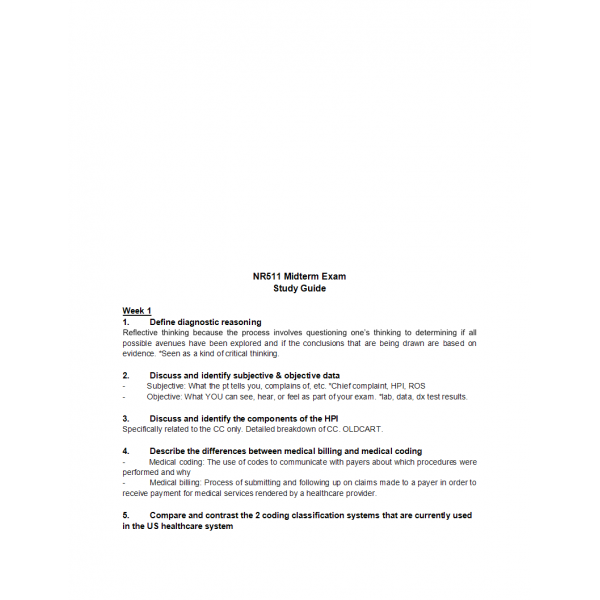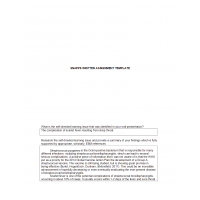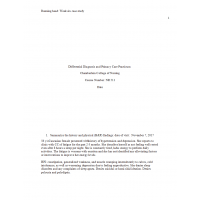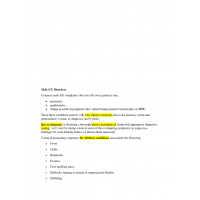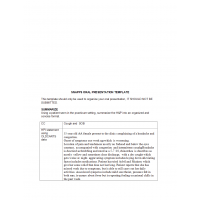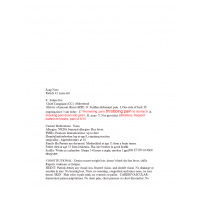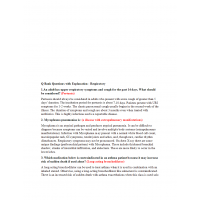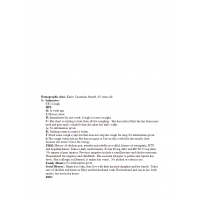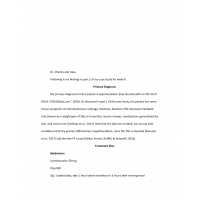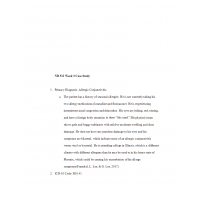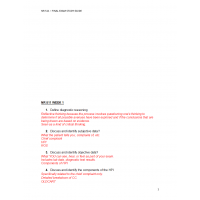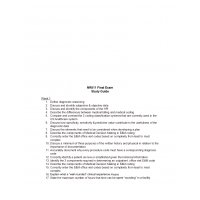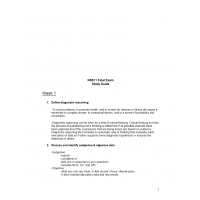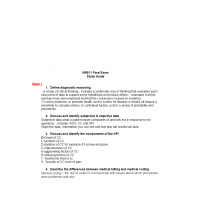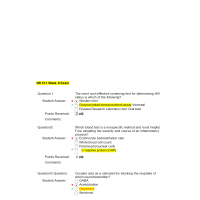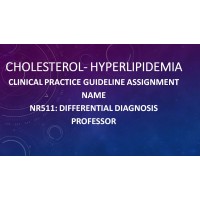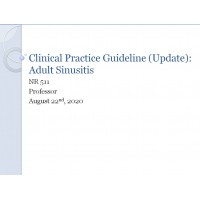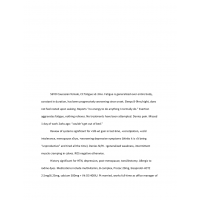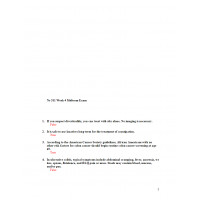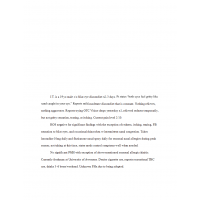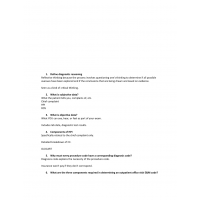NR 511 Midterm Exam Study Guide
Week 1
1. Define diagnostic reasoning
2. Discuss and identify subjective & objective data
3. Discuss and identify the components of the HPI
4. Describe the differences between medical billing and medical coding
5. Compare and contrast the 2 coding classification systems that are currently used in the US healthcare system
6. Discuss how specificity, sensitivity & predictive value contribute to the usefulness of the diagnostic data
7. Discuss the elements that need to be considered when developing a plan
8. Describe the components of Medical Decision Making in E&M coding
9. Correctly order the E&M office visit codes based on complexity from least to most complex
10. Discuss a minimum of three purposes of the written history and physical in relation to the importance of documentation
11. Accurately document why every procedure code must have a corresponding diagnosis code
12. Correctly identify a patient as new or established given the historical information
13. Identify the 3 components required in determining an outpatient, office visit E&M code
14. Describe the components of Medical Decision Making in E&M coding
15. Correctly order the E&M office visit codes based on complexity from least to most complex
16. Explain what a “well rounded” clinical experience means
17. State the maximum number of hours that time can be spent “rounding” in a facility
18. State 9 things that must be documented when inputting data into clinical encounter
19. Identify and explain each part of the acronym SNAPPS
Week 2
1. Identify the most common type of pathogen responsible for acute gastroenteritis
2. Recognize that assessing for prior antibiotic use is a critical part of the history in patients presenting with diarrhea
3. Describe the difference between Irritable Bowel Disease (IBS) and Inflammatory
4. Discuss two common Inflammatory Bowel Diseases
5. Discuss the diagnosis of diverticulitis, risk factors, and treatments
6. Identify the significance of Barrett’s esophagus
7. Discuss the diagnosis of GERD, risk factors, and treatments
8. Discuss the differential diagnosis of acute abdominal pain, work-up and testing, treatments
9. Discuss the difference between sensorineural and conductive hearing loss
10. Identify the triad of symptoms associated with Meniere's disease
11. Identify the symptoms associated with peritonsillar abscess
12. Identify the most common cause of viral pharyngitis
13. Identify the most common cause of acute nausea & vomiting
14. Discuss the importance of obtaining an abdominal xray to rule out perforation or obstruction even though the diagnosis of diverticulitis can be made clinically
15. Discuss colon cancer screening recommendations relative to certain populations
16. Identify at least two disorders that are considered to be disorders related to conductive hearing loss
19. Identify common characteristics in a rash caused be Group A Strep
20. Discuss that the diagnosis of streptococcal pharyngitis can be made clinically based on the Centor criteria:
21. Describe an intervention for a patient with gastroenteritis
22. Discuss an appropriate treatment for prophylaxis or treatment of traveler's diarrhea
23. Identify at least one effective treatment for Irritable Bowel Syndrome (IBS)
24. Identify at least one prescription medication for the treatment of chronic constipation
25. Discuss at least one treatment for Meniere's disease
Week 3
1. Discuss that the majority of dyspnea complaints are due to cardiac or pulmonary decompensation-
2. Explain the differences between intra-thorax and extra-thorax flow disorders
3. Identify at least three examples of flow and volume disorders (intra and/or extra thorax)
4. Discuss diagnosis, risk factors and treatments for asthma
5. Describe appropriate tests in the work up for dyspnea-
6. Discuss clinical findings and PFTs for asthma, chronic bronchitis, emphysema, and COPD
7. Differentiate between the following common rashes:
8. Differentiate between the following tineas: pedis, cruris, corporis and unguium and describe an appropriate treatment
9. Identify the virus that causes warts
10. Differentiate between atopic and contact dermatitis and give examples of each
11. Identify common characteristics associated with blepharitis, chalazion and hordeolum
12. Differentiate between viral, allergic, bacterial, toxic and HSV conjunctivitis (CH.8 & lecture)
13. Discuss which chemical injury is associated with the most damage and highest risk to vision loss -
14. Recognize common eye emergency conditions that require emergency room evaluation
15. Discuss glaucoma, diagnosis and treatment
16. Discuss diabetic retinopathy
| Institution & Term/Date | |
| Term/Date | Chamberlain University |
NR 511 Week 4 Midterm Study Guide 3
- Product Code: 2021
- Availability: In Stock
-
$22.00
Related Products
NR 511 Week 8 Reflection
$10.00
NR 511 Week 4 Midterm Exam
$25.00
NR 511 Week 8 Final Exam 2
$40.00
NR 511 Week 8 Final Exam 1
$35.00
NR 511 Week 2 Study Guide
$12.00

